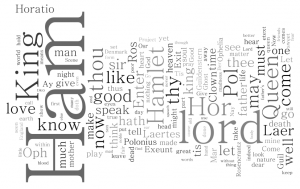I used wordle to create a visualization of the Shakespearian play, “Hamlet,” using the digital version from Project Gutenberg. Other than “Ham,” which is the abbreviation for Hamlet that signifies when he is speaking, the largest, most commonly used words are “lord,” “king,” and “queen.” These words of political position reveal not only the main characters in the play, but also the nature of the conflict and the power struggle within the play between Hamlet, and his uncle, King Claudius. Some other heavily recurring words include “good,” “well,” “soul” and “heaven” which also demonstrates Hamlet’s own inner conflicts of his desire for revenge and his fear of going to hell. “Speak,” “think,” and “now” further demonstrate his indecisiveness as he puts off his revenge as time continues to run out. Shakespeare also examines human “nature” and one’s “fear” or acceptance of “death” throughout the play. While this is an accurate representation of underlying themes and motifs within “Hamlet” and roughly outlines the plot, it does not explicitly show that Hamlet wants to avenge his father’s death by killing Claudius. However, it does a good job reflecting the overall mood, as well as the significant aspects that one would not necessarily collect from reading a summary. I believe this visualization is an accurate representation of the play.
One tool that would be useful for distant reading, besides a sort of family tree, which already exists, would be a mapping of the characters and their place in time. Since it is a play, it would be interesting to see the position of the characters on the stage, and which direction they are facing. The interface could be just a giant rectangle (like a stage) and the characters could come in an out of the stage, represented by their names or how they appear in the play. The direction the words are facing can represent the way the characters turn or behave.

